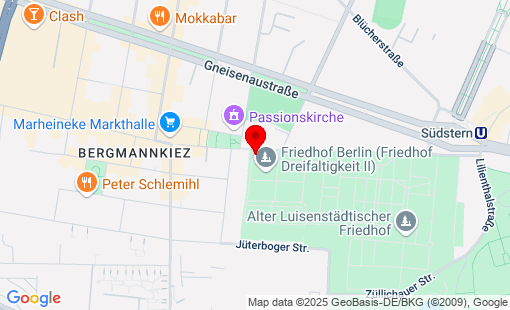Germany
Berlin-Kreuzberg, Dreifaltigkeitsfriedhof II
Total Occupation: 194 fatalities
Total Occupation: 194 fatalities
The Dreifaltigkeitsfriedhof II was established in 1825 as the second cemetery of the Dreifaltigkeitskirchengemeinde and the first of four cemeteries on today's Bergmannstraße in Kreuzberg on a former vineyard; Friedrichswerdersche Friedhof II was established on its eastern border in 1844. This hillside location, which is quite unusual for Berlin, is still noticeable today. The four cemeteries are considered the most species-rich green space in Berlin with a particularly high density of breeding birds. The 4.9-hectare cemetery contains numerous monumental burials and mausoleums from the 19th century, such as for the Oppenheim alias von Oppenfeld banking family. Karl Friedrich Schinkel, for example, created the tomb of the Prussian Minister of War Carl von der Osten-Sacken. Various personalities rest in this cemetery: - Jesse Fairfield Carpenter (1853-1901), inventor of the railroad air brake - Martin Gropius (1824-1880), architect of, among other things, the former Museum of Decorative Arts, which is now named after him (grave of honor); the tomb is by himself - Johann Georg Halske (1814-1890), co-founder of the Siemens & Halske company - Robert Held (1862-1924), developed S. Lorenz AG (later SEL) into an international electronics company - Cuno Horkenbach (1883-1968), resistance fighter and escape helper for victims of Nazi persecution - Georg Klingenberg (1870-1925), innovative engineer at AEG - Karl von Lukas (1860-1932), infantry general in the Austro-Hungarian army - Adolph von Menzel (1860-1932), founder of the company Siemens & Halske - Adolph von Menzel (1860-1932), founder of the company Siemens & Halske. Army - Adolph von Menzel (1815-1905), important historical painter (e.g. of Frederick II, but also of modern life, e.g. "The Iron Rolling Mill"; grave of honor); the tomb was created by Reinhold Begas - Theodor Mommsen (1817-1903), important historian of antiquity and 1902 Nobel Prize winner in literature (grave of honor) - Georg Wertheim (1857-1939), co-founder of the Wertheim department store chain; the Jewish family was expropriated by the National Socialists.
There are also other graves of honor in the state of Berlin:
- Franz Bopp (1791-1867), linguist (grave of honor) - Fredy Budzinski (1879-1970), sports journalist important to cycling (grave of honor) - Charlotte von Kalb (1761-1843), writer and lover of Friedrich Schiller (grave of honor) - August Kopisch (1799-1853), Karl Lachmann (1793-1851), Germanist and co-founder of historical-critical editing practice (grave of honor) - Philipp Konrad Marheineke (1780-1846), ev. Georg Heinrich Pertz (1795-1876), historian and librarian (grave of honor) - Friedrich Ludwig Georg von Raumer (1781-1873), liberal jurist, historian and political scientist (grave of honor) - Georg Andreas Reimer (1776-1842), liberal publisher (grave of honor) - Friedrich Daniel Schleiermacher (1768-1834), ev. Friedrich Daniel Schleiermacher (1768-1834), Protestant theologian and philosopher and founder of modern hermeneutics (honorary grave); the tombstone was created by Christian Daniel Rauch - Ludwig Tieck (alias Peter Leberecht) (1773-1853), poet and playwright ("Puss in Boots", honorary grave) The round church of the Dreifaltigkeitsgemeinde, built in 1737-1739 on Mauerstraße, was destroyed during the Second World War. 30 fallen soldiers from the First World War and almost 370 victims of the Second World War, mainly civilian dead, rest in the Dreifaltigkeitsfriedhof II cemetery (Martin Bayer, 15.04.2020)
